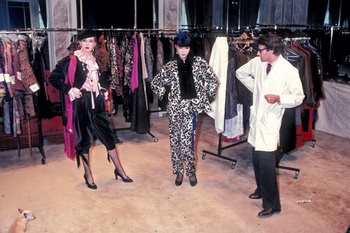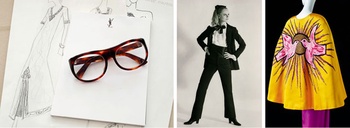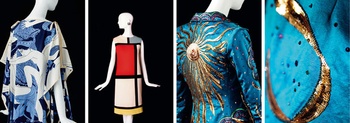From his famous Mondrian dress to the collection of paper dolls and dresses he designed as a teenager, the “Yves Saint Laurent: a Visionary” exhibition showcases exclusive and unseen work by the renowned French designer.
Born in 1936, Yves Saint Laurent spent most of his youth in Oran, Algeria. He had always been fascinated by fashion and design, and at the early age of 17, he joined French haute couture house Dior. When in 1957, Christian Dior passed away unexpectedly, Saint Laurent became Dior’s head designer. He was only 21 years old. Not long after, he started his own fashion house with his partner Pierre Bergé.
Until his death in 2008, Yves Saint Laurent was one of the world’s most renowned designers. Nearly all of his creations have been kept by the Fondation Pierre Bergé–Yves Saint Laurent. From this impressive archive, fashion historian and curator Florence Müller gathered around a hundred dresses, sketches, and documents for the exclusive ING exhibition “Yves Saint Laurent: a Visionary”.
Are there any fashion trends today, that trace back to Yves Saint Laurent’s creations?
Florence Müller: Certainly. Yves Saint Laurent loved to play with the opposition between male and female, an opposition that was traditionally kept separated in fashion. As of 1962, he started mixing female outfits with male influences. Women wearing a suit or a smoking jacket, a jumpsuit, or even shorts, that was something no other designer had ever done before. It resulted in a timeless look, adapted to women in the city, always on the move. He also experimented with the vintage look in the 1970s and designed garments as if they came right out of a thrift shop.
What’s so typical about his designs?
Müller: His style balances between both the minimal and the baroque. He created black dresses with very minimal cuts, as well as some pieces with heavy embroidery in bright colours. Think of the transparent dress from 1966 for instance, where only a patch of embroidery covers the female chest, allowing women to wear the dress without revealing too much. Everything Yves Saint Laurent created was made for active women. Dresses for example always had the necessary pleats and creases to move around easily. There’s only one dress in the exhibition that doesn’t abide by this rule: a knitted woolen wedding dress that fits the body like a cocoon.
Yves Saint Laurent: back to the future of fashion

(Fondation Pierre Bergé-Yves Saint Laurent © Photo: G. Marineau)

(Fondation Pierre Bergé-Yves Saint Laurent © Photos on the left and right: S. Carre)
What can we expect from the exhibition?
Müller: About eighty percent of the items on display have never been shown before, which makes it a rather exclusive exhibition. People who have visited the retrospective expo in Paris won’t see the same things in Brussels. The “Visionary” expo is built up as a parcours, and will give visitors a good grasp on Yves Saint Laurent’s creations and philosophy. After an introduction, there’s a long gallery narrating the story of his collections from 1962 until 2002. Compare it to a time-line, with a different shelf displaying sketches and drawings for every year. One of the oldest items in the exhibition is the paper doll house he made in his teens. We’ve had some reproductions made, for the audience to play with.
There are also several rooms dedicated to themes that were important during Saint Laurent’s career: colours, seduction through the juxtaposition of male and female, his more affordable collection Rive Gauche, and accessories. I’ve made a selection of 230 accessories, none of them have ever been showcased before. Saint Laurent believed accessories to be a vital part of an outfit and he used any sort of material to make them. He once said that if you didn’t have anything to wear, good accessories could make all the difference.
What can we expect from the exhibition?
Müller: About eighty percent of the items on display have never been shown before, which makes it a rather exclusive exhibition. People who have visited the retrospective expo in Paris won’t see the same things in Brussels. The “Visionary” expo is built up as a parcours, and will give visitors a good grasp on Yves Saint Laurent’s creations and philosophy. After an introduction, there’s a long gallery narrating the story of his collections from 1962 until 2002. Compare it to a time-line, with a different shelf displaying sketches and drawings for every year. One of the oldest items in the exhibition is the paper doll house he made in his teens. We’ve had some reproductions made, for the audience to play with.
There are also several rooms dedicated to themes that were important during Saint Laurent’s career: colours, seduction through the juxtaposition of male and female, his more affordable collection Rive Gauche, and accessories. I’ve made a selection of 230 accessories, none of them have ever been showcased before. Saint Laurent believed accessories to be a vital part of an outfit and he used any sort of material to make them. He once said that if you didn’t have anything to wear, good accessories could make all the difference.

(Fondation Pierre Bergé-Yves Saint Laurent © Photos: S. Carre)
Nearly everything on display belongs to the Fondation Pierre Bergé–Yves Saint Laurent. That must be an impressive archive.
Müller: It contains more than 5,000 dresses, over 15,000 accessories, and around 35,000 sketches, drawings, and other documents. Yves Saint Laurent was the first fashion house to keep and conserve its creations. This was a rare thing to do in the 1970s, as there were no fashion or clothing museums around, and most designers got rid of their collection and documentation once the season was over. Saint Laurent wanted to preserve everything to showcase later and to be used as educational material for new designers. This proves how much of a visionary he was. Because of this, Yves Saint Laurent was the first designer ever to have a museum show, in 1983 at the Metropolitan Museum of Art in New York.
Going through the archives, what are the most intriguing things you found?
Müller: Sketches, order books, everything really. It’s a long-winded process from the first drawings to the actual piece of clothing. One of the last parts of the exhibition is about the “making of” of his garments. Illustrated by a video, visitors will get a glimpse behind the scenes of Saint Laurent’s fashion house and come to see how complex the craft of haute couture really is.
Yves Saint Laurent: A Visionary • 30/1 > 12/5, ma/lu/Mo > zo/di/Su 10 > 18.00 (wo/me/We > 21.00), ING Cultuurcentrum/Espace Culturel ING, Koningsplein 6 place Royale, Brussel/Bruxelles, 02-547.22.92
Nearly everything on display belongs to the Fondation Pierre Bergé–Yves Saint Laurent. That must be an impressive archive.
Müller: It contains more than 5,000 dresses, over 15,000 accessories, and around 35,000 sketches, drawings, and other documents. Yves Saint Laurent was the first fashion house to keep and conserve its creations. This was a rare thing to do in the 1970s, as there were no fashion or clothing museums around, and most designers got rid of their collection and documentation once the season was over. Saint Laurent wanted to preserve everything to showcase later and to be used as educational material for new designers. This proves how much of a visionary he was. Because of this, Yves Saint Laurent was the first designer ever to have a museum show, in 1983 at the Metropolitan Museum of Art in New York.
Going through the archives, what are the most intriguing things you found?
Müller: Sketches, order books, everything really. It’s a long-winded process from the first drawings to the actual piece of clothing. One of the last parts of the exhibition is about the “making of” of his garments. Illustrated by a video, visitors will get a glimpse behind the scenes of Saint Laurent’s fashion house and come to see how complex the craft of haute couture really is.
Yves Saint Laurent: A Visionary • 30/1 > 12/5, ma/lu/Mo > zo/di/Su 10 > 18.00 (wo/me/We > 21.00), ING Cultuurcentrum/Espace Culturel ING, Koningsplein 6 place Royale, Brussel/Bruxelles, 02-547.22.92
Read more about: Expo
Fijn dat je wil reageren. Wie reageert, gaat akkoord met onze huisregels. Hoe reageren via Disqus? Een woordje uitleg.